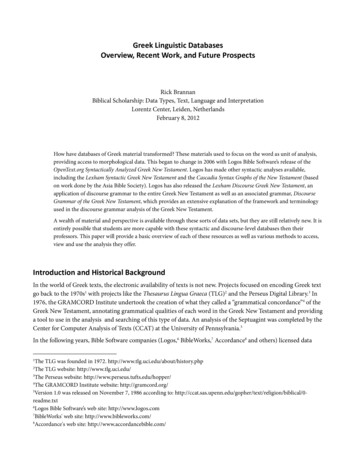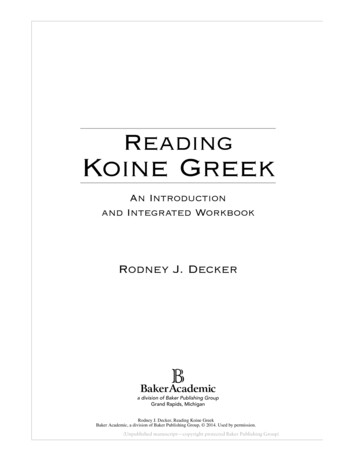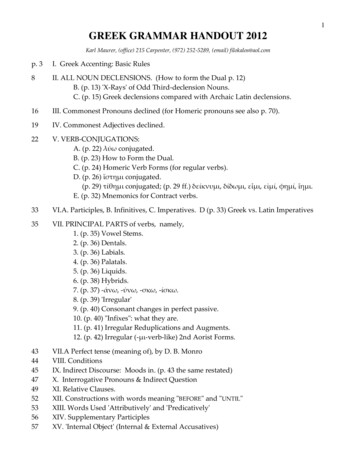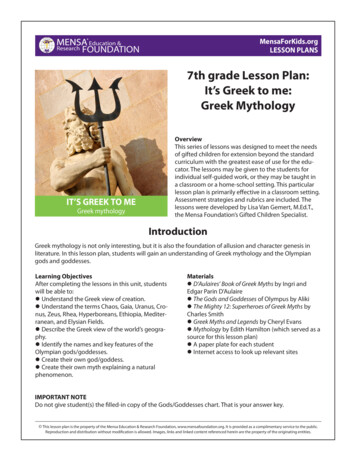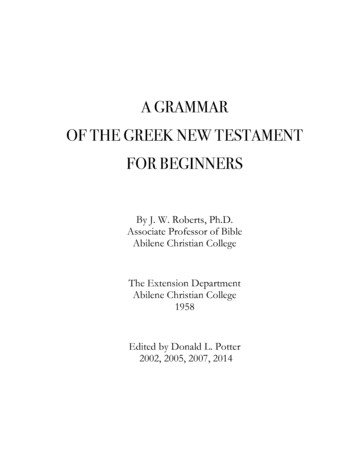
Transcription
A GRAMMAROF THE GREEK NEW TESTAMENTFOR BEGINNERSBy J. W. Roberts, Ph.D.Associate Professor of BibleAbilene Christian CollegeThe Extension DepartmentAbilene Christian College1958Edited by Donald L. Potter2002, 2005, 2007, 2014
Copyright 2014 Donald L. PotterAll rights reserved.ISBN: 1502549204ISBN-13: 978-1502549204www.donpotter.net
DEDICATIONTO MY FATHER – ORSON D. POTTERWHOSE HEART FELT ENCOURAGEMENTAND DEVOUT PRAYERSMADE THIS EDITION POSSIBLE.
ACKNOWLEDGMENTSI would like to acknowledge great encouragement that I received from Dr. Ian Fair, who was the Dean atthe Sunset School of Preaching (Sunset International Bible School) in Odessa, Texas in the mid 1970’swhen I was a student there. I did not study Greek with Dr. Fair, but I did substitute as Greek Instructor forhim a few time. I recall that he taught William Hershey Davis’ highly respected Beginners’ Grammar of theGreek New Testament. When I asked Dr. Fair if there would be any problems with me republishing Robert’sgrammar, he assured me that, not only would their not be any problems, but that I would be doing a greatservice. He taught Robert’s Grammar in the Natal School of Preaching in South Africa, when he was amissionary there. He agreed that Robert’s Grammar is one of the very best ever published and encouragedme to go ahead and publish my edition.I received great encouragement and practical assistance from Wayne Price, a former student of Dr. Robertsand long time teacher of his beginning Greek method. Brother Price and his students used early typed pagesof my work on this edition and sent me many suggestions for corrections and improvements.David Singleton loaned me his heavily annotated copy of Dr. Robert’s Grammar to use with my edition. Hewas one of Dr. Robert’s last students. Dr. Roberts was planning a new edition when he passed away.Brother Singleton’s copy had many marginal notes with changes that Dr. Robert’s was planning to make. Ihave done my best to incorporate those changes into this edition. It was my good fortune to be teaching forthe Ector County Independent School District when David was the Language Arts Curriculum Director.Dr. Louis Tyler helped with some of the early editing. I consider his recordings of Biblical text (LXX andNT) to be an essential component of my approach to teaching Greek with its emphasis on listening tospoken Koiné Greek. While initially adopting Modern Greek pronunciation for NT Greek, Dr. Tylereventually switched to Erasmian. He has used his rich linguistic talents to give us beautiful, fluent recordingsof the Biblical texts that are available from his website, http://audiohebrewgreekbible.com. His recordingof the book of Ephesians is available in mp3 format on my website for free download.I would like to express my immense gratitude to Gerald Payden, who was my instruction in “MissionLinguistics” at the Sunset International Bible Institute School of Missions in 1974. He introduced me to thegreat work of the Summer Institute of Linguistics. We studied the works of Kenneth Pike, Eugene Nida,Donald Larson, William Smalley, and others. I used the language learning techniques Brother Payden taughtme to teach myself Spanish - in record time. I have used those skills daily as a certified elementary publicschool bilingual teacher (English & Spanish) and as a secondary Spanish teacher. I currently teach Spanishat the Odessa Christian School in Odessa, TX, where those skills benefit another generation of students.To the late Dr. J. W. Roberts, I owe an immense debt of gratitude for writing this splendid Grammar of theGreek NT for Beginners. Unfortunately, I never had the pleasure of meeting him. I purchased my copy of hisGrammar at a Friends of the Library Sale on February 22, 1999. I marveled at the grammatical detail (actuallysomething of an intermediate grammar), the extensive leveled readings, the linguistically organized exercises,and expansive vocabulary. While it is to be deeply regretted that he passed away before he was able topublish a second edition of his Grammar, I pray that my edition - of what he called “the best testedGrammar of Koiné Greek” - will prove to be a blessing to students who desire to be able to read theirGreek New Testament fluently at sight. Dr. Roberts wrote several small paperback commentaries for R. B.Sweet that served a generation of Bible students. He published numerous papers for scholarly journals. Hisundergraduate and graduate students have made signal contributions to Biblical scholarship.
CONTENTSPART IINTRODUCTION.PagePRONUNCIATION AND ORTHOGRAPHYiPART II: essonLessonLessonLessonLessonLessonLesson1. Conjugation of ω-verbs: Present Indicative Active . . . . . . . . . . . . . . . . . . . . 12. Declension of η-nouns . . . . . . . . . . . . . . . . . . . . . . . . . . . . . . . . . . . . . . . . . 43. α-stems of the First Declension . . . . . . . . . . . . . . . . . . . . . . . . . . . . . . . . . . 84. Prepositions . . . . . . . . . . . . . . . . . . . . . . . . . . . . . . . . . . . . . . . . . . . . . . . . . 115. Contract (εω) Verbs . . . . . . . . . . . . . . . . . . . . . . . . . . . . . . . . . . . . . . . . . . . 146. Declension of α-stems (Concluded), Masculines in –ης and –ας . . . . . . . . . 177. The Passive Voice. Present Indicative Passive . . . . . . . . . . . . . . . . . . . . . . 208. The Middle Voice. Present Indicative Middle . . . . . . . . . . . . . . . . . . . . . . . 239. Second (ο) Declension. Nouns in –ας ; Verbs in αω . . . . . . . . . . . . . . . . . . 2610 Second Declension. Neuter Stems in ο; Verbs in οω . . . . . . . . . . . . . . . . . . 2911 Adjectives of the Vowel Declension . . . . . . . . . . . . . . . . . . . . . . . . . . . . . . 3212 Regular Verbs in –µι . . . . . . . . . . . . . . . . . . . . . . . . . . . . . . . . . . . . . . . . . . . 3613 Conjugation of εἰµ". The Personal Pronoun . . . . . . . . . . . . . . . . . . . . . . . . . 3914. Imperfect Indicative Active . . . . . . . . . . . . . . . . . . . . . . . . . . . . . . . . . . . . . 4415. Imperfect Indicative Middle-Passive . . . . . . . . . . . . . . . . . . . . . . . . . . . . . . 4716. The Demonstratives. Reflexive Pronouns . . . . . . . . . . . . . . . . . . . . . . . . . . 5117. Deponent (Defective) Verbs . . . . . . . . . . . . . . . . . . . . . . . . . . . . . . . . . . . . 5518. The Future Tense . . . . . . . . . . . . . . . . . . . . . . . . . . . . . . . . . . . . . . . . . . . . . 5819. The Future Tense (Continued) . . . . . . . . . . . . . . . . . . . . . . . . . . . . . . . . . . . 6220. The Aorist Tense . . . . . . . . . . . . . . . . . . . . . . . . . . . . . . . . . . . . . . . . . . . . 6521. The Second Aorist Tense . . . . . . . . . . . . . . . . . . . . . . . . . . . . . . . . . . . . . . 6922. The Aorist Tense (Continued) . . . . . . . . . . . . . . . . . . . . . . . . . . . . . . . . . . . 7223. Perfect Active Indicative Active . . . . . . . . . . . . . . . . . . . . . . . . . . . . . . . . . 7524. The Perfect Active (Continued) . . . . . . . . . . . . . . . . . . . . . . . . . . . . . . . . . 7825. The Pluperfect Tense . . . . . . . . . . . . . . . . . . . . . . . . . . . . . . . . . . . . . . . . . 8126. The Perfect Indicative Middle and Passive . . . . . . . . . . . . . . . . . . . . . . . . 8427. The Aorist Passive . . . . . . . . . . . . . . . . . . . . . . . . . . . . . . . . . . . . . . . . . . . 8728. The Future Passive . . . . . . . . . . . . . . . . . . . . . . . . . . . . . . . . . . . . . . . . . . 9129. The Principal Parts . . . . . . . . . . . . . . . . . . . . . . . . . . . . . . . . . . . . . . . . . . . 9330. The Third Declension . . . . . . . . . . . . . . . . . . . . . . . . . . . . . . . . . . . . . . . . . 9631. Liquid Nouns of the Third Declension . . . . . . . . . . . . . . . . . . . . . . . . . . . 10032. The Relative Pronoun . . . . . . . . . . . . . . . . . . . . . . . . . . . . . . . . . . . . . . . . . 10433. Mute Stems of the Third Declension . . . . . . . . . . . . . . . . . . . . . . . . . . . . . 10834. Third Declension Stems in –οντ. The Active Participle . . . . . . . . . . . . . . . 11135. Sibilant Stems (-ες) of the Third Declension . . . . . . . . . . . . . . . . . . . . . . 11636. The Middle and Passive Participles . . . . . . . . . . . . . . . . . . . . . . . . . . . . . . 11937. The Genitive Absolute. Supplementary Participle . . . . . . . . . . . . . . . . . . 12238. The Aorist Passive Participle. Syncopated Stems of the 3rd Declension . . 12639. The Subjunctive Mood . . . . . . . . . . . . . . . . . . . . . . . . . . . . . . . . . . . . . . . . 129
CONTENTSLessonLesson 40.Lesson 41.Lesson 42.Lesson 43.Lesson 44.Lesson 45.Lesson 46.Lesson 47.Lesson 48.Lesson 49.Lesson 50.PageThe First Aorist Subjunctive. Vowel Stems of the 3rd Declension . . . . . . .Second Aorist Subjunctive . . . . . . . . . . . . . . . . . . . . . . . . . . . . . . . . . . . . .Conditional Sentences: Logical and Unreal . . . . . . . . . . . . . . . . . . . . . . . .Conditional Sentences: Anticipatory. Indefinite and Interrogative Pronouns.The Imperative Mood . . . . . . . . . . . . . . . . . . . . . . . . . . . . . . . . . . . . . . . . .Numbers . . . . . . . . . . . . . . . . . . . . . . . . . . . . . . . . . . . . . . . . . . . . . . . . . . .Comparison of Adjectives . . . . . . . . . . . . . . . . . . . . . . . . . . . . . . . . . . . . .Irregular Comparison of Adjectives. . . . . . . . . . . . . . . . . . . . . . . . . . . . . .The Optative . . . . . . . . . . . . . . . . . . . . . . . . . . . . . . . . . . . . . . . . . . . . . . . .The Periphrastic Tenses . . . . . . . . . . . . . . . . . . . . . . . . . . . . . . . . . . . . . . .Adverbs and Their comparison. . . . . . . . . . . . . . . . . . . . . . . . . . . . . . . . . .132135138141144148151154158162164Grammatical Index . . . . . . . . . . . . . . . . . . . . . . . . . . . . . . . . . . . . . . . . . . . . . . . . . . . . . 167Vocabulary (English – Greek) . . . . . . . . . . . . . . . . . . . . . . . . . . . . . . . . . . . . . . . . . . . . . 173Vocabulary (Greek – English) . . . . . . . . . . . . . . . . . . . . . . . . . . . . . . . . . . . . . . . . . . . . . 179Brief Biography of Dr. J. W. Roberts . . . . . . . . . . . . . . . . . . . . . . . . . . . . . . . . . . . . . . . . 197
iIntroductionPronunciation and OrthographyA. The Greek Alphabet. The Greek Alphabet is made up of twenty-four letters. Many of themare like their English and Latin counterparts, both in form and sound. Those that are not may beeasily learned with practice. The following material aims at approaching the problem of learningthe alphabet though what the average person already knows of words derived from Greek. Asnearly as possible, English derivatives with the same pronunciation as their Greek originals havebeen selected to illustrate the sounds.There are two types of Greek letters: capitals, called Uncials, and small letters, called Cursives:Cursives: αβγδεζηθικλUncials: Α ΒΓ ΔΕΖ ΗΘΙΚ ΛEnglish:gezthika bdēlµνξΜ Ν Ξm nοπρσ (ς) τυφχψωΟ ΠΡΣΤΥΦΧΨΩorstuphch psōxpMost Greek texts and lexicons use the small letters, except for beginning proper names. Thestudent should learn the cursives only at first. Sigma has two forms: σ inside a word and ς at theend of a word.B. Pronunciation. The following paragraphs are to aid the student in learning the properpronunciation. A few preliminary things must be given which will be given in greater detail later:Accents: There are three accents—acute, ( ), grave ( ), and circumflex ( ). There is nodifference among them. Like our English accents in a dictionary, they merely indicate the stresssyllable.Breathings: All vowels or diphthongs which begin a Greek word must have either a smooth ( ) orrough ( ) breathing. The smooth breathing does not affect pronunciation; the rough gives theword an h-sound at the beginning.Division of Syllables: There are as many syllables in a Greek word as there are separate vowels ordiphthongs. A single consonant between two vowels is pronounced with the second vowel; e.g.,ἀ-νά. A consonant-group which may not begin a word (Consult the Vocabulary) is divided, e.g.,ἔρ-χοµαι. Double consonants are divided; e.g. τάσ-σω. Consonants which can begin a word arepronounced with the following vowel; e.g., κύ-κλος. Compound words are divided where theyjoin; e.g., ἐκ-βάλλω.C. The Alphabet. Learn the following, practice diligently:αἄλφα alpha (äl fä) - a as in fatherἀπόστολος (apostle)ἄνθρωπος (anthropos)δόγµα(dogma)Try: analysis)(sabbath)ἀγαπάω ἀγάπη �ἀλαλάζω(deca-)(ecclesia)(Psallo)
iiββῆτα beta (bā tä) b as in ball (voiced bilabial ��ζω(baptism)(Baptist)(baptize)Try: βαρσαββᾶςγγάµµα1Try: γῆδβασιλείαγεγάρTry: ἐλεέωζβρῶµαTry: ζητέωἦτα (agora, “market place”)(logos)(magi, “wise γίγνοµαιδέρωδέωδή(dendron, “tree”)(cardia, “heart”; cf. cardiac)(exodus)(doxology, p si lon) - e as in met(episkopos, “bishop”(epistle)(“other” cf. �ἐµάἐµόν(ethnos, “nation” cf. Ethnology)(ethics)(theos, “God”)(Peter)(peri-, around)δέησιςTry: δή(baptize)(rantize, �ἐθέλω(Zeus)(zone “girdle”)(“a yoke” cf. zeugma)Ζοροβάβελ(ā tä) - e as in they, prey, �τα zeta (zā tä) z as in zebra (voiced tip dental affricate /dz/ became voiced alveolar fricative ηβρέφος(delta)(dogma)(deca-; decalogue)(despot)(derma; epidermi)ἐ ψιλόν �ςφοβίαπρεσβύτερος(dél tä) - d as in do (voiced dental stop)Try: lossary)(pragmatic)(genesis)δέλτα �ςδέρµα(barbarous)(Bible)(blasphemy)(gä mä) - g as in go (voiced back velar �ρβαροςβίβλοςβλασφηµίαγ before κ, γ, χ, or ξ is to be pronounced ng. e.g., ἄγγελος, angel(amen)(denarius)ἤπερἔτηἦ
iiiθθῆτα theta (thä tä) - th as in thin (voiceless dental τοςἔθοςἔθνοςTry:ι(cf. arithmetic, “number”)(theater)(“death” cf. Thanatopsis)(ethics)(ethnos, ethnology)θεάTry: ἴδιοςTry: �δεῖνἰδού(“priest” cf. �� cf. ief” cf. kleptomania)(“heart” cf. cardiac)(acme)(“watchman,” scope)(canon)καταβάλλωλάµβδα lambda (lamb dä) - l as in let (voiced tip alveolar lateral �οςδέλταγλῶσσαTry: λαλέωµθέλωκάππα kappa (käp pä) - k as in skip (voiceless back velar stop - hos, “feeling”)ἰῶτα iota (i ō tä) - i as in ίανλίθοςλογία(leo, asm)λογίζοµαιµῦ mu (mü) - m as in man (voiced bilabial όςµάγοςµάρτυςTry: µνῆµα(mystery)(metathesis)(moron)(magi, “wise men”)(martyr, ή(micro-, hosis)χάσµα φίληµα
ivννῦ nu (nü) - n as in now (voiced tip alveolar �ννέοςκανώνTry: ας(koiné)(gnosis)(throne)(Sabbath)(dendron, �ύςπρᾶξιςξένοςνύξ(“flesh” cf. sarcasm)(“sharp,” oxygen)(“deed” cf. practice)ξυρέωὄ µικρόν omicron (ŏm i kron) - aw as in law (ou as in bought)(apostle)(octo-, “eight”)(“rightly”, cf. �όςTry: �ος(petros, “a rock” Peter)πέτρα(petra, “rock)πρεσβύτερος l)παράκλητος (paraclete)πῦρ, ῶςπρόπερίπρός(panoply, “full armor”)(”walk around” peripatetic)(“horse” “river,”hippopotamus)(“fire,” pyre)προσήλυτοςπροσαγωγήrho (rhō) - r as in run (voiced tip alveolar Try:(catholic)(prophet)(logos, “word”)(“law” Deuteronomy)(scope)(pē) - p as in spike (voiceless bilabial stop – unaspirated)πῖ piTry: ἐπίρνοµοθεσία(exodus)(“praise” doxology)(“ladder,” �σάββατονδένδρον(ksi) - ks as in the sound of box (voiced back velar penta- “five”)(pneumatic)(nymph)(“new” cf. neophyte)(canon)ῥίζα(rodah rone)(critic)(Rome)ποδός
vστς (final) σίγµα (síg mä) - s as in sit (voiceless tip alveolar risis)(scandal)Try: σόςσκηνήταῦTry: )(hyacinth)ἡδύςφῖ phi (phē) - ph as in phone (voiceless labio-dental ηµίαTry: ανθρωπίαφίλανδροςχί (chē) - ch as in Christ or lock (voiceless velar όνοςχαρακτήρTry: χάριςψσῶζωὔ ψιλόν (úp si lon) - somewhat like the u in virtue (French tü) [front rounded vowel]Try:χσύν-ειµι(Pentecost)(place” topology)(talent, a sum of eismograph)(Satan)(philosophy)(Stephen, “crown”)(tau) t as in stop (voiceless tip dental stop - hrist)(Christian)(chronology)(character “stamp”)χήρα �ςτάχαταχέως(cheo, “I pour)(chiton, a garment)(chiliasm “1000”)τεῖχοςψῖ (psē) - ps as in lips (voiceless bilabial ιστος(psallo)(pseudo-, “false”)(false Christ)Try: he)(psalm)
viωὦ µέγα omega (ō mēg ä) - o as in �ζοµαιTry: ὧδε(ode)(hosanna)(glossary)(agonize: ἀγών, a �ζω (baptize, this finalω is the 1st personending of the verb)γράφωλέγωD. Diphthongsαι aiai as in AH-ee γυναικεῖος (gynecologist, “female”); αἵρεσις (heresy; sect)Try: καί καινός αἰνέωει ei - ei as in reign, rein πειθός (pathos) Try: δεῖ εἰς εἷς εἰµίοι oi - oi as in oil κοινή (koiné) Try: οἴδα οἰκία οἶκοςαυ au - au as in sauerkraut (AH-oo) ταὐτό (“the same”; tautology)Try: παύω αὐτός αὐτοῦ αὔριονευ eu - eu as in EH-oo Ζεύς (Zeus) εὐφωνή (euphony) Try: δεύτερος πλευρά εὖ εὐλογίαου ou - ou as in group ἀκούω (acoustic) Try: οὖτος οὕτως οὖς οὖνυι ui - (pronounce as “we”) Try: υἱόςυἱοθεσίαα, ε, ο, η, and ω are pronounced with the mouth well open and are called open vowels. ι and υare pronounced with the mouth nearly closed and are called close vowels. Diphthongs are formedby combining an open vowel and a close vowel (in that order) except υι which is formed by twoclose vowels. ηυ is pronounced as e as in obey u in rude. ᾳ, ῃ and ῳ are improper diphthongs.The iota subscript is not pronounced, but it often determines the form of the word.E. Punctuation. The punctuation marks used in Greek differ from English. A dot at the top of aline ( · ) is the semicolon in Greek. The sign of the English ( ; ) in Greek is the question mark.F. Exercises.(a) Write in cursive Greek script:sophian de laloumen en tois teleiois; sophian de ou tou aiōnos toutou, oude tōn archontōntou aiōnos toutou, tōn katargoumenōn· alla laloumen sophian theou en mustēriō, tēnapokekrummenēn, hēn proōrisen ho theos pro tōn aiōnōn eis doxan ēmōn, hen oudeis tōnarchontōn tou aiōnos toutou egnōken· ei gar egnōsan ouk an tou kurion tēs doxēs estaurōsan·alla kathōs gegraptai, ha opthalmos ouk eide, kai ous ouk ēkouse, kai epi kardian anthrōpououk anebē ha hētoimasen ho theos tois agapōsin auton· hēmin de ho theos apekalupse dia toupneumatos autou. I Corinthians 2:6-10a
vii(b) Write in English letters (transliterate) the following:Πάντων δὲ τὸ τέλος ἤγγικεν. σωφρονήσατε οὖν καὶ νήψατε εἰς προσευχάς· πρὸπάντων τὴν εἰς ἑαυτοὺς ἀγάπην ἐκτενῆ ἔχοντες, ὅτι ἀγάπη καλύπτει πλῆθοςἁµαρτιῶν· φιλόξενοι εἰς ἀλλήλους ἄνευ γογγυσµοῦ· ἕκαστος καθὼς ἔλαβεν χάρισµα,εἰς ἑαυτοὺς αὐτὸ διακονοῦντες ὡς καλοὶ οἰκονόµοι ποικίλης χάριτος θεοῦ· εἲ τιςλαλεῖ, ὡς λογία θεοῦ· εἴ τις διακονεῖ, ὡς ἐξ ἰσχύος ἦς χορηγεῖ ὁ θεός· ἵνα ἐν πᾶσινδοξάζηται ὁ θεὸς διὰ Ἰησοῦς Χριστοῦ, ᾧ ἐστιν ἡ δόξα καὶ τὸ κράτος εἰς τοὺς αἰῶναςτῶν αἰώνων· ἀµήν. I Peter 4:7-11G. Accents. The accents of Greek word indicate the stress of voice in communications. Nearlyall Greek words must be written with accents.It is difficult but important to learn the accents. They serve to distinguish some words and areimportant in learning Greek.The three accents : the acute ( ), the grave ( ̀ ), and the circumflex ( ̃ ).These were probably different in sound (probably musical designations), but any distinction insound has been lost. They all merely indicate stress of voice. The accent stands over the vowel ofthe accented syllable, over the second vowel of an accented diphthong.ὁ ὑιὸς τοῦ θεοῦ ἔχει τὴν ἐξουσίαν.There are a number of rules that determine which accent can stand at a given position on aGreek word. These rules are somewhat complicated, and the student must expect to becomeproficient in their use only by practice.The most important of these concern the position, length, and special rules for verbs and nouns.1. No accent may ever stand on any but the last three syllables of a Greek word.2. An acute accent may stand only on the antepenult (the 3rd syllable from the end), the penult(2nd syllable from the end), or the ultima (the last syllable). Cf. ἄνθρωπος, καρδία, ἀδελφός(But ἄσθαενεια would violate the rule. ἀσθένεια is correct.)*3. A circumflex may stand on either the penult or the ultima, but not on the antepenult:e.g., ἐξῆλθον, τοῦ (But εξῆλθοµεν would violate this rule.)*4. A grave may stand only on the ultima. τὸ ἔργον (But never ἒργον)*5. A syllable is long if it contains a long vowel (η and ω) or a diphthong (e.g., αυ, ου) Howeverαι and οι are short when they are the final letters in a word. In ἄνθρωποι, οι is short; butin ἀνθρώποις, οι is long since a σ follows.6. A grave or an acute accent may stand on either a long or short syllable.ἄνθρωπος, ἀνθρώπῳ, τὸν αὐτόν7. A circumflex accent can stand only on a long syllable. τοῦ, τοῦτο8. If the penult is long and is accented, the accent must be circumflex if the ultima is short,but the circumflex cannot stand on the penult if the ultima is long.τοῦτο τούτουοὗτος οὕτου
viii9. An acute accent cannot stand on the antepenult when the ultima is long.ἄνθρωποι ἀνθρώπων10. An acute accent on the ultima is changed to a grave when another word follows it incomposition without an intervening mark of punctuation. τό τὸ ἔργον(A few words to be learned later form exception to this; e.g., with enclitics and theinterrogative pronoun.)11. A long ultima may have either a circumflex or acute accent.(The general rules only fix the limits of accents; they do not tell where the accent will be ona given word. The following rules are necessary for this.)12. The accent of verbs is recessive; that is, it is not fixed, but it tends to get as far away fromthe ultima as the rules allow.λαµβάνω, λαµβάνετε, ἦλθε, ἤλθοµενThis means that a verb will be accented on the antepenult when the ultima is short, but on thepenult when the ultima is long.λαµβάνει λαµβµάνουσι13. In nouns the accent is fixed by conventional pronunciation in the nominative case, which mustbe learned for each noun just as in English. Once the accent is learned, it is to be kept on thesame syllable in the nominative, if the rules permit; e.g., αδελφός, ἄνθρωπος, καρδία,δῶρον, ποιµήν, ποιµένος.Rules already given force changes in the genitive case; e.g. ἀνθρώπου (Rule 9) δώρου (Rule 8)Yet in the accusative case ἄνθρωπον the accent goes back to the same position as in thenominative, for the ultima is short.The chief thing to remember is that for nouns the accent is not recessive as in verbs.14. 1st and 2nd Declension nouns accent a long ultima (if it is accented) with a circumflex in thegenitive, ablative, dative, instrumental, and locative cases. θεός, θεοῦ, θεοῦ, θεῷ, θεῷ,θεῷ, θεόν.15. In the 1st Declension the genitive and ablative plurals of all nouns are circumflex. This isbecause the form ῶν is a contraction of an original άων. ἡ ἐκκλησία τῶν ἐκκλησιῶνt16. Monosyllabic nouns of the 3rd Declension accent the genitive, ablative, dative, instrumental,and locative cases on the ultima. νύξ, νυκτόςσάρξ, σαρκός.The special rule for enclitics will be given later.
ixH. Contraction of Vowels. When two vowel sounds come together they are often contractedinto one syllable. Such contraction is governed by four rules:1. Two vowels which together would make one of the regular diphthongs unite to do so:ἔθνεσι ἔθνε-ι ἔθνει2. Two vowels which do not make one of the regular diphthongs unite. If the vowels are like(two o-sounds, two e-sounds, or two a-sounds, whether long or short) they form a commonlong vowel (ᾶ, η or ω). However ε ε gives ει, and ο ο gives ουδολόω δολῶφιλέη φιλῆποιεετε ποιεῖτε3. If two vowels which cannot form a diphthong are unlike, one assimilates the other.(a) an o-sound (ο/ω) takes the precedence over an a-sound (α) or an e-sound (ε/η) andbecomes ω. But οε and εο give ου. Γεννάω γεννῶ(b) an a-sound or e-sound takes precedence over one another according to which comesfirst in the word and gives the corresponding long vowel.γενναητε γεννᾶτεἐλάλαε ἐλάλα4. A vowel and a diphthong unite in the following way: if the vowel before a diphthong is thesame as that with which the diphthong begins, it is absorbed and disappears; ε is absorbedbefore οι. In case the vowel is different from the first vowel of the diphthong, it combines withthe first vowel of the diphthong like rule #3 and the iota is put as a subscript.µνάαι µναῖγεννάοι γεννῷRULE OF ACCENT: If one of the contracting syllables had the accent, the contraction takes thecircumflex accent, otherwise the regular rules apply. See former example.Ι. Accent of Enclitics. Enclitics are words which are commonly pronounced with wordspreceding them, just as proclitics are words pronounced with those following them, e.g.ἐµοῦ, µου·ὁ ἀδελφός µου.Such enclitics usually lose their accents except in the following instances:1. An enclitic or proclitic followed by an enclitic retains its accent: e.g.οὗτοι οἱ αδελφοί µού εἰσι. οὔκ εἰµι.2. An enclitic of two syllables retains its accent after a word accented with an acute accenton the penult, e. g., ὁ νόµος ἐστὶν ἀγαθός.3. An enclitic of two syllables retains its accent after a sentence or when it is emphatic, e.g.ἐστίν is written ἔστιν at the beginning of a sentence, if it means he exists or it ispossible and when it comes after ἀλλά, εἰ, καὶ, µή, οὐκ, ὅτι, τοῦτο, ὡς.The noun preceding an enclitic receives an additional accent (acute), on the ultima if it isaccented on the antepenult (e.g. ὁ ἄνθρωπός µου) or has a circumflex accent on the penult,(e.g. τό πλοῖόν µου.)J. Movable Nu. Any verb and noun forms which end in a vowel insert a ν, called a “movableNu” before another word which begins with a vowel. The letter serves merely to separate thewords and has no meaning. Some words also originally had a movable sigma which has becomeattached as part of the spelling of the word.Corrected 10/06/05, 4/9/06 (Dr. Louis Tyler’s help), 3/30/2015. Be sure to listen to the audioinstruction on Mr. Potter’s website: www.donpotter.net. Mr. Potter’s pronunciation follows therecommendations in W. Sidney Allen’s Vox Graeca: The Pronunciation of Classical Greek (1987).
1Lesson 1Conjugation of ω-verbs: Present Indicative ActiveΝυνὶ δὲ µένει πίστις, ἐλπίς, ἀγάπη. But now abides faith, hope, love. I Cor. 13:131. Verbs. The verb is the word in the sentence which affirms or predicates something; e.g.,Paul preaches. The Greek verb has a very full inflection, but most of its forms are represented insome way in the English verb system. As in English, the verb forms are divided into finite verbs(those limited by person and number and which define predication) and the infinitive or verbalforms (those which are not limited as to person and number; e.g., the infinitive, to preach, and theparticiple, preaching.2. Omega-Verbs. There are two types of verb conjugations in Greek. The more numerousis the type that ends in ω in the first person singular present indicative. These are called Omegaverbs. The other type ends in µι and is called the µι-verbs. The ω-verbs are later but havepractically displaced the other type.3. The Verb λύω. A verb of the type λύω is described or “located” as “present indicativeactive first singular.” This means that the verb is in the present tense, the indicative mood, theactive voice, the first person, and the singular number. The student must understand what thesemean before he can proceed. They mean nearly the same thing in English:Tense means “kind of action” (not time, as in English); i.e., whether the action iscontinuous or stated as a point. Present tense denotes action that is continuous or going on.This kind of action is
A GRAMMAR OF THE GREEK NEW TESTAMENT FOR BEGINNERS By J. W. Roberts, Ph.D. Associate Professor of Bible Abilene Christian College The Extension Department Abilene Christian Colle
